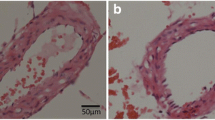We examined expressions of E-selectin and myeloperoxidase (MPO) in cerebral tissues after cerebral ischemia-reperfusion (CIR) in rats and evaluated neuroprotective effects of atorvastatin under these conditions. Immunohistochemical methods were used to detect E-selectin and MPO expression in the tissue. Small numbers of E-selectin- and MPO-positive cells were observed in the sham group within 4 to 24 h time intervals. In the operation group, numerous positive cells were found in the cortex and hippocampus after CIR. E-selectin expression occurred at 4 h, peaked at 12 h, and returned to nearly normal levels at 24 h. However, E-selectin expression in the intervention (CIR + atorvastatin) group was significantly lower than that in the operation group at each time (P < 0.05). Myeloperoxidase had nearly similar timing of changes in E-selectin expression, and MPO expressions at different time points in the intervention group were significantly lower than those in the operation group (P < 0.05). Therefore, expressions of E-selectin and MPO change dynamically after CIR. Atorvastatin, an agent having antiinflammatory properties, demonstrates an obvious protective effect with respect to acute CIR-related damage.
Similar content being viewed by others
References
X. Ren, K. Akiyoshi, A. A. Vandenbark, et al., “Programmed death-1 pathway limits central nervous system inflammation and neurologic deficits in murine experimental stroke,” Stroke, 42, No. 9, 2578-2583 (2011).
T. Miyazaki, Y. Kimura, H. Ohata, et al., “Distinct effects of tissue-type plasminogen activator and SMTP-7 on cerebrovascular inflammation following thrombolytic reperfusion,” Stroke, 42, No. 4, 1097-1104 (2011).
X. Wu, D. Lin, G. Li, and Z. Zuo, “Statin post-treatment provides protection against simulated ischemia in bovine pulmonary arterial endothelial cells,” Eur. J. Pharmacol., 636, Nos. 1/3, 114-120 (2010).
J. L. Haylor, K. P. Harris, M. L. Nicholson, et al., “Atorvastatin improving renal ischemia reperfusion injury via direct inhibition of active caspase-3 in rats,” Exp. Biol. Med., 236, No. 6, 755-766 (2011).
H. C. Xu, L. B. Qian, X. C. Ru, et al., “Electrophysiological effect of atorvastatin on isolated rat hearts injured by ischemia/reperfusion,” Zhejiang Da Xue Xue Bao Yi Xue Ban, 39, No. 6, 589-593 (2010).
A. Schneider, A. Martin-Villalba, F. Weih, et al., “NF-kappaB is activated and promotes cell death in focal cerebral ischemia,” Nat. Med., 5, No. 5, 554-559 (1999).
I. Ditnag, C. Iadecola, and M. Moskowitz, “Pathobiology of ischemic stroke: an integrated view,” Trends Neurosci., 22, No. 9, 391-397 (1999).
B. A. Haines, S. L. Mehta, S. M. Pratt, et al., “Deletion of mitochondrial uncoupling protein-2 increases ischemic brain damage after transient focal ischemia by altering gene expression patterns and enhancing inflammatory cytokines,” J. Cereb. Blood Flow Metab., 30, No. 11, 1825-1833 (2010).
A. Ottani, D. Giuliani, M. Galantucci, et al., “Melanocortins counteract inflammatory and apoptotic responses to prolonged myocardial ischemia/reperfusion through a vagus nerve-mediated mechanism,” Eur. J. Pharmacol., 637, Nos. 1/3, 124-130 (2010).
Y. Matsuo, H. Onodera, Y. Shiga, et al., “Correlation between myeloperoxidase-quantified neutrophil accumulation and ischemic brain injury in the rat. Effects of neutrophil depletion,” Stroke, 25, No. 7, 1469-1475 (1994).
H. Chen, M. Chopp, and G. Bodzin, “Neutropenia reduces the volume of cerebral infarct after transient middle cerebral artery occlusion in the rat,” Neurosci. Res. Commun., 93, No. 11, 93-97 (2002).
M. Ali, A. E. Hicks, P. G. Hellewell, et al., “Polymers bearing sLex-mimetics are superior inhibitors of E-selectin-dependent leukocyte rolling in vivo,” FASEB J., 18, No. 1, 152-154 (2004).
J. Huang, T. F. Choudhri, C. J. Winfree, et al., “Postischemic cerebrovascular E-selectin expression mediates tissue injury in murine stroke,” Stroke, 31, No. 12, 3047-3053 (2000).
T. Zhou, J. L. Chen, W. Song, et al., “Effect of N-desulfated heparin on hepatic/renal ischemia reperfusion injury in rats,” World J. Gastroenterol., 8, No. 5, 897-900 (2002).
H. Du, N. Liu, and Z. Wu, “Interleukin-10 inhibits cerebral ischemia-reperfusion E/ L-selectin expression,” Chinese Med. J., 1, No. 89, 59-62 (2009).
J. Huang, T. F. Choudhri, C. J. Winfree, et al., “Postischemic cerebrovascular E-selectin expression mediates tissue injury in murine stroke,” Stroke, 31, No. 12, 3047-3053 (2000).
C. J. Frijns and L. J. Kappelle, “Inflammatory cell adhesion molecules in ischemic cerebrovascular disease,” Stroke, 33, No. 8, 2115-2122 (2002).
A. Mueck, H. Seeger, and D. Wallwiener, “Further evidence for direct vascular action of statin: effect on endothelial nitric oxide synthase adhesion molecules,” Exp. Clin. Endocrinol. Diabets, 3, No. 1099, 181-183 (2001).
L. Wang, Y. Mei, and Z. Sun, “The changes of cerebral infarction patients’ serum MCP-1 and the atorvastatin intervention role,” Shanxi Med. Univ. Press, 4, No. 40, 344-347 (2009).
G. W. Cockerill, T. Y. Huehns, A. Weerasinghe, et al., “Elevation of plasma high-density lipoprotein concentration reduces interleukin-1-induced expression of E-selectin in an in vivo model of acute inflammation,” Circulation, 103, No. 1, 108-112 (2001).
R. Liu, L. Zhang, X. Lan, et al., “Protection by borneol on cortical neurons against oxygen-glucose deprivation/reperfusion: involvement of anti-oxidation and anti-inflammation through nuclear transcription factor kappaB signaling pathway,” Neuroscience, 176, 408-419 (2011).
H. L. Zhang, M. Xu, C. Wei, et al., “Neuroprotective effects of pioglitazone in a rat model of permanent focal cerebral ischemia are associated with peroxisome proliferator-activated receptor gamma-mediated suppression of nuclear factor-kappaB signaling pathway,” Neuroscience, 176, 381-395 (2011).
M. A. Read, M. Z. Whitley, S. Gupta, et al., “Tumor necrosis factor alpha-induced E-selectin expression is activated by the nuclear factor-kappaB and c-JUN N-terminal kinase/p38 mitogen-activated protein kinase pathways,” J. Biol. Chem., 272, No. 5, 2753-2761 (1997).
Author information
Authors and Affiliations
Corresponding author
Rights and permissions
About this article
Cite this article
Cao, H., Zhong, W., Wu, W. et al. Effects of Atorvastatin on E-Selectin and Myeloperoxidase Expressions after Cerebral Ischemia-Reperfusion Injury in Rats. Neurophysiology 46, 331–337 (2014). https://doi.org/10.1007/s11062-014-9452-3
Received:
Published:
Issue Date:
DOI: https://doi.org/10.1007/s11062-014-9452-3




